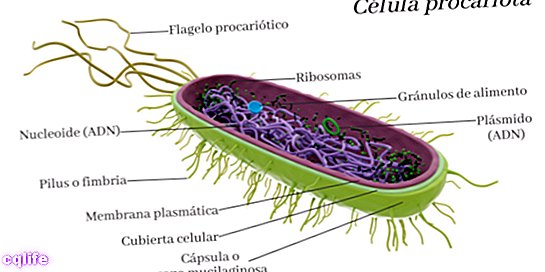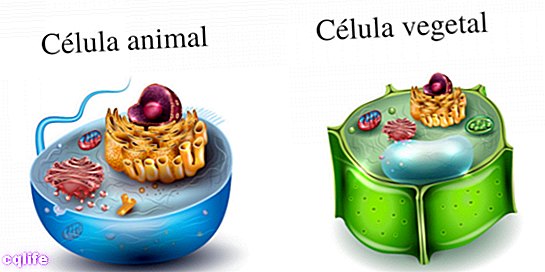We explain what the cell is and what types of cells exist. Also, what are the parts and functions of cells.
organisms. The cell constitutes the smallest and simplest form of biological organization, that is, the structure smallest living and orderly known (most of the virus They are smaller than a cell, but there is disagreement among scientists regarding their origin and whether or not they are living beings).
The cell is said to be the functional unit of all living beings because all cells are capable of carrying out the functions of nutrition, metabolism, response to stimuli, information processing, reproduction and growth.
The cell is said to be the structural unit of the living beings because all organisms are made up of cells. Some organisms are made up of a single cell and are called single-celled organisms while others, called multicellular organisms, are made up of a large number of cells of different types (which are usually specialized in specific functions).
The size of the cells can vary enormously: some can be practically visible with the naked eye, although the vast majority of them are microscopic, that is, they can only be seen using a microscope. An average cell is around 10 µm (micrometers), but cell size varies widely: there are some that measure as little as 1 µm and others 100 µm.
Cells can reproduce by two possible mechanisms: division by mitosis, which gives rise to two identical daughter cells, and the division by meiosis, which allows the formation of gametes (sex cells). In meiosis there is exchange of Genetic information and four different daughter cells are produced, with half the genetic content of the initial cell.
Inside the cells there are organelles or organellesSimpler structures that have specialized and differentiated shapes. Within the organelles the various biochemical functions necessary for cell survival and functioning are carried out.
The discovery of the cell is considered the foundational step in the modern study of the life (biology), since it allowed to understand the enormous complexity of the body of living beings and allowed the emergence of numerous Sciences Y disciplines later.
Cell types
The most important classification of cells has to do with the presence or absence of a membrane that delimits the cell nucleus. This distinction is fundamental in the history of evolution, since it allows us to differentiate cells into two broad categories:
- Prokaryotic cells. They have a simple basic structure without organelles and without a nuclear envelope, so their genetic material is dispersed, occupying a space called the nucleoid, and which is in direct contact with the rest of the cytoplasm. Prokaryotic cells are the smallest and are between 1–5 µm in size. They were the first life forms in the Earth, and these organisms are much simpler than eukaryotes. All living things made up of prokaryotic cells are unicellular.
- Eukaryotic cells. Eukaryotic cells have a more complex structure than prokaryotes and have membrane-bound organelles in their cytoplasm. The main characteristic of this type of cell is that it has a defined nucleus, where its genetic material is found. Eukaryotic cells are larger than prokaryotic but have sizes that can vary widely between 10-100 µm. These cells appeared later than the prokaryotes in the history of the Earth and constitute a step forward in the evolution of life since they allow a greater range of complexity. Eukaryotic cells are usually part of complex and multicellular organisms, although they can also constitute unicellular organisms (such as yeast).
Despite the differences between prokaryotes and eukaryotes, there are great similarities in their molecular organization and functions.For example, both types of organisms use the same genetic code and similar machinery to synthesize protein.


There is great morphological diversity within eukaryotic cells, among which animal cells and plant cells stand out. Although both have structures in common, they also have some differences (in relation to the functions they perform), as shown below.

- Both animal and plant cells possess mitochondria, which are the organelles where cellular respiration takes place, a process that allows the cell to obtain energy for all its functions.
- The cell nucleus is another characteristic shared by both types of cells. This membranous structure houses the genetic material of the cell (DNA).
- The vegetables cells They have a rigid cell wall, composed mainly of cellulose. This structure shapes the cell and supports the cell. plant (Plant organisms do not have skeletons like animals). In addition, plant cells have a large vacuole that stores Water and nutrients and, by occupying a large part of the cell volume, it gives rigidity to these cells.
- Plant cells have chloroplasts, organelles where the photosynthesis, process by which the plant synthesizes its own food. These organelles are unique to plant cells.
- The animal cells They do not have a cell wall and are very diverse and often irregular in shape. For their part, plant cells are usually larger and prismatic in shape.
- Animal cells have two unique structures (that is, they are not found in plant cells): the centrioles, which participate in cell division, and the lysosomes, which are small vesicles that contain enzymes digestive systems and are involved in the degradation of cellular structures.
Parts of a cell
Cells have various organelles and delimited sectors:
- The plasma membrane. It is a biological boundary that delimits the interior of the cell from its exterior. It is made up of a continuous double layer of phospholipids and proteins interspersed or adhered to its surface, whose function is to separate the content of the cell from the environment that surrounds it and allow the entry and exit of substances. Thus, they can enter nutrients and excrete waste.
- Cellular wall. It is a thick and stable barrier, external to the plasma membrane, which gives it a certain rigidity and endurance to the cell. The cell wall is present in prokaryotic cells and organisms eukaryotes It is only found in the cells of plants and mushrooms. The cell wall is manufactured based on various resistant materials and is variable in each type of organism.
- Core. It is a structure limited by a double membrane nuclear envelope. The nucleus is an organelle exclusive to eukaryotic cells and inside it contains most of the genetic material of the cell (DNA).
- Cytoplasm. It is the gelatinous substance that fills the interior of the cell, located between the plasma membrane and the nucleus (when present), and made up of water, salts, proteins and other substances. The main function of the cytoplasm is to support the organelles of the cell and to assist in the metabolic processes that occur within it.
- Organelles They are internal membranous structures that are found in the cell and that perform specific roles. Some of them are:
- Mitochondria. They are the structures where cellular respiration takes place, a process that allows the cell to obtain Energy.
- Lysosomes. They deal with digestion and the use of nutrients.
- Chloroplasts They are structures (exclusive of plant cells) that contain chlorophyll, essential for photosynthesis that takes place inside.
- Ribosomes. They deal with the synthesis of proteins, a process necessary for cell growth and reproduction.
- Flagella They are organelles present in certain cells and serve to propel themselves in the environment. They are typical of unicellular beings or mobile cells such as sperm.
Functions of a cell
Cells can have very diverse and complex functions:
- Structural functions. Build tissues, such as adipose tissue (fat), muscle tissue and bone tissue (bones), which support the body and its organs.
- Secretory functions. Generate essential substances for life and the self-regulation of the organism, as do the mucous membranes or the glands.
- Metabolic functions. Break down nutrients or transport them throughout the body, as digestive cells in the intestine and red blood cells do in the blood, respectively.
- Defensive functions. Help the body to defend itself from external agents and eliminate them, or to fight diseases, as do white blood cells.
- Control functions. Coordinate the enormous diversity of body processes, transmitting information and generating specific reactions to certain stimuli (such as the neurons).
- Reproductive functions. Combine with other sex cells from another organism of the same species to give rise to a new individual (sexual reproduction), or divide (on its own) by mitosis to produce a new individual identical to the parent (asexual reproduction).
